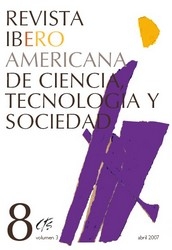Da Demonstração Especializada ao Diálogo Participativo
DOI:
https://doi.org/10.52712/issn.1850-0013-947Palavras-chave:
ciência, políticas, regulação, questões ambientaisResumo
Este artigo analisa o papel da ciência no desenvolvimento e na implementação de políticas. Apresentam-se e discutem-se, em particular, diversos modelos conceituais (principalmente o modelo moderno) que descrevem a relação e as interfaces entre a ciência e as políticas de regulação de questões ambientais. Considerando que esses modelos apresentam pressupostos subjacentes, pontos fortes e limitações — e que nenhum deles oferece uma solução universal — o autor propõe articular novas alternativas com base na reformulação desses modelos.
Downloads
Referências
BECK, U. (1992): Risk Society: Towards a new modernity, Sage, London.
BUSH, V. (1945): Science -The Endless Frontier, A Report to the President by Vannevar Bush, Director of the Office of Scientific Research and Development, July 1945 (United States Government Printing Office, Washington: 1945), http://www.nsf.gov/od/lpa/nsf50/vbush1945.htm
CBD (1992): “Cartagena Protocol on Biosafety”. Disponible en: http//www.biodiv.org/biosafe/protocol
DE MARCHI, B. (2003): “Public participation and risk governance”, Science and Public Policy, Nº30, 3, June 171-176.
EU (2002): “Communication from the Communities on the collection and use of expertise by the commission: principle and guidelines” (COM 2002:713), Brussels.
EU (2001): “Communication from the Commission on the precautionary principle” (COM 2000:1), Brussels.
EU (2001): “Directive 2001/18/EC of the European Parliament and of the Council on the deliberate release into the environment of genetically modified organisms and repealing”, Council Directive 90/220/EEC, Brussels.
FISHER, R.A. (1951): The Design of Experiments, 6th edition, Oliver & Boyd, Edinburgh.
FUNTOWICZ, S.O. (2006): “Why Knowledge Assessment?”, S. Vaz , A. Pereira (eds): Interfaces between Science and Society, EC Joint Research Centre, (en prensa).
FUNTOWICZ, S.O., RAVETZ, J.R. (1993): “Science for the post normal age”, Futures 25:739-755.
FUNTOWICZ, S.O., RAVETZ, J.R. (1990): “Uncertainty and Quality in Science for Policy”, Kluwer, Dordrecht, 7-16.
GIGERENZER, G. (2004): “Mindless Statistics”, The Journal of Socio-Economics, 33: 587-606.
LASH, S., SZERSZYNSKI, WYNNE, B [ed.] (1996): Risk, Environment & Modernity -Towards a New Ecology, TCS Sage, London.
LATOUR, Bruno (1993): We have never been modern, Harvard University Press, Cambridge Mass., USA.
LOSEY, J.E., RAYOR, L.S., CARTER, M.E. (1999): “Transgenic pollen harm monarch larvae”, Nature, 399:214
LYOTARD, J.F. (1984): “The Postmodern Condition: A Report on Knowledge”, Bennington G & Massumi B. Foreword by Jameson F. Minneapolis: University of Minnesota Press & Manchester: University of Manchester Press.
MARRIS, C., WYNNE, B., SIMMONS, P., WELDON, S. (2001): “Public perceptions of agricultural biotechnologies in Europe”, Final report of the PABE research project, Lancaster, UK: University of Lancaster.
NOWOTNY, H, SCOTT, P., GIBBONS, M. (2001): Re-thinking science: knowledge and the public in an age of uncertainty, Cambridge, Polity Press.
QUIST, D., CHAPELA, I.H. (2001): “Transgenic DNA introgressed into traditional maize landraces in Oaxaca, Mexico”, Nature, 414:541-543.
REES, M. (2003): Our Final Hour, Basic Books.
SCIENTIFIC COMMITTEE ON PLANTS (1999): “Opinion of the Scientific Committee on the Invocation of Austria of Article 16 (‘safeguard’ clause) of Council Directive 90/220/EC with respect to theplacing on the market of the Monsanto genetically modified maize (MON810) expressing the Bt cryia(b) gene, notification”, C/F/95/12/02.
STRAND, R. (2002): “Complexity, Ideology and Governance”, Emergence, 4:164-183.
STRAND, R. (2001): “The role of risk assessment in the governance of genetically modified organisms in agriculture”, Journal of Hazardous Materials, 86:187-204.
WEINBERG, A. (1972): “Science and tran-science”, Minerva, 10:209-222
WYNNE, B. (1992): “Uncertainty and environmental learning: reconcieving science and policy in the preventive paradigm”, Global Environmental Change, 2:111-127.
Downloads
Publicado
Como Citar
Edição
Seção
Licença
Copyright (c) 2025 CC Attribution 4.0

Este trabalho está licenciado sob uma licença Creative Commons Attribution 4.0 International License.
Todas os números de CTS e seus artigos individuais estão sob uma licença CC-BY.
Desde 2007, a CTS proporciona acesso livre, aberto e gratuito a todos seus conteúdos, incluídos o arquivo completo da edição quadrimestral e os diversos produtos apresentados na plataforma eletrônica. Esta decisão é baseada no entendimento de que fornecer acesso livre aos materiais publicados ajuda a ter uma maior e melhor troca de conhecimentos.
Por sua vez, em se tratando da edição quadrimestral, a revista permite aos repositórios institucionais e temáticos, bem como aos sites pessoais, o autoarquivo dos artigos na versão post-print ou versão editorial, logo após da publicação da versão definitiva de cada número e sob a condição de incorporar ao autoarquivo um link direcionado à fonte original.











